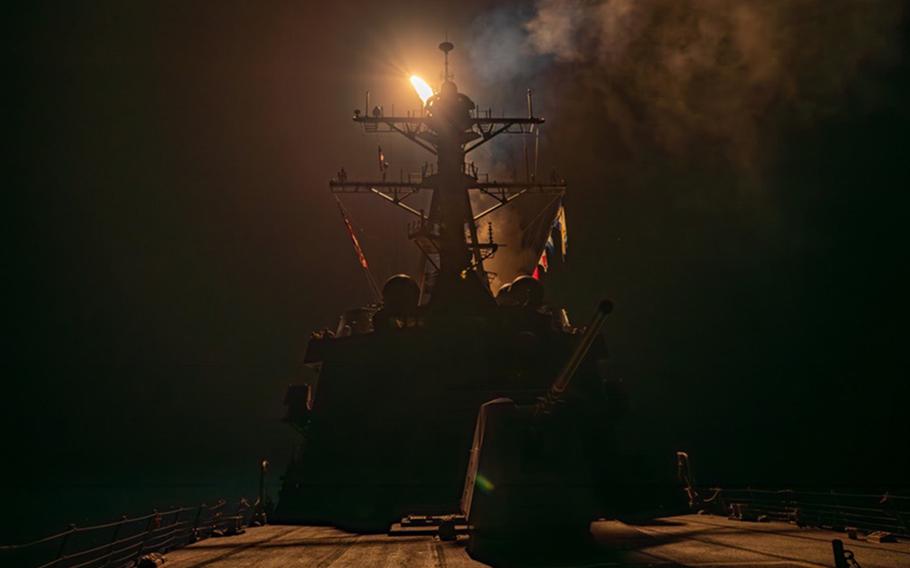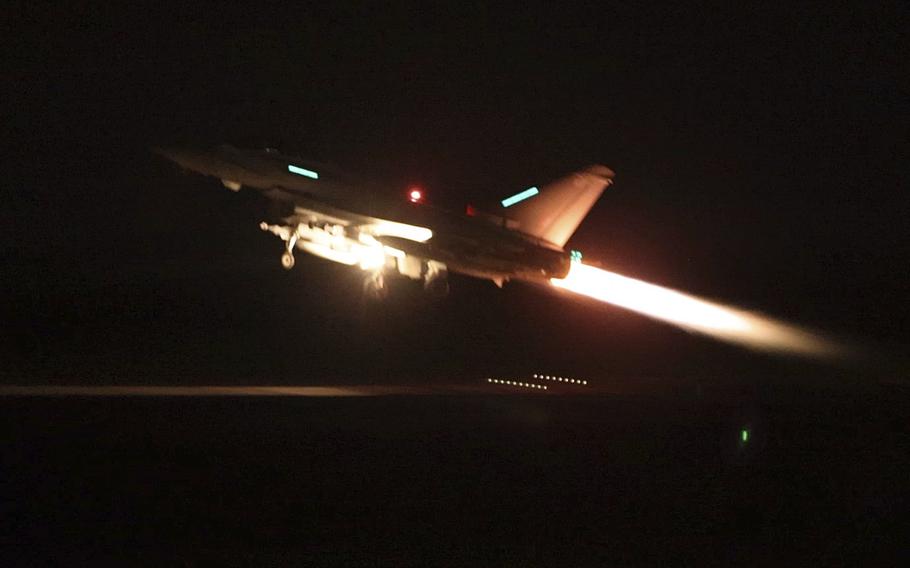Middle East
How the US and UK came to attack the Houthis in Yemen
Bloomberg News January 13, 2024

A Tomahawk missile launches from an unidentified U.S. destroyer on Jan. 12, 2024, targeting Iranian-backed Houthi militant sites in Yemen. (U.S. Central Command)
WASHINGTON (Tribune News Service) — President Joe Biden was vacationing in St. Croix on the morning of Jan. 1 when he convened a meeting of his national security team. Pressure had been building for weeks for military action against Iran-backed Houthi militants for their persistent attacks on shipping in the Red Sea.
Just a day earlier, the Yemen-based Houthis had fired on U.S. Navy helicopters responding to a distress call from a container ship. The Navy fired back, sinking three small boats and killing their crews. Amid the near-daily Houthi attacks on container ships and tankers over six weeks, shipping costs were rising and critics of Biden’s leadership were warning that American credibility was on the line.
The meeting set in motion 12 days of diplomacy and military planning that culminated in the airstrikes on over 60 Houthi targets — all while trying to avert a wider Mideast war. The strikes on Thursday evening U.S. time, followed by a follow-up strike on a radar installation on Friday night, were by far the most wide-ranging military action undertaken by the United States since Hamas’s Oct. 7 attack on Israel ignited its operation to eliminate militants in Gaza. Biden said the military action sent a “clear message.”
This is how those plans unfolded, according to U.S. and British officials who provided details on condition of anonymity.
During the conference on New Year’s Day, Biden directed his team to accelerate efforts to condemn the Houthi attacks at the United Nations and to continue building a multilateral coalition intended to defend shipping. But he also gave instructions to prepare to proceed on a second track if diplomacy failed, telling military leaders to refine a list of targets to hit in tandem with allies.
In the days after the meeting, discussions with UK politicians and defense planners accelerated.
The two countries discussed options that included special forces operations, more aggressive action at sea and strikes on land. The U.S. pushed for strong action from the beginning, while UK, European and Middle East allies cautioned that an overzealous response could draw the West into direct conflict with Iran.
In the background, both U.S. and UK officials pondered the economic impact of a wider war in an election year for both countries. Official assessments warned of significant inflationary impacts and a hit to GDP if a full-blown Mideast war erupted.
Private diplomacy — and public messaging — continued. On Jan. 3, the U.S. and 13 other countries issued a joint statement warning of “consequences” if the Houthis failed to halt their attacks in the Red Sea.
In private, the U.S. sent repeated back-channel messages to Iran, urging it to stop the Houthi attacks. Tehran responded that it had no control over the group, despite continued indications from UK intelligence that showed the Houthis restocking with weapons that could be traced to Iran.
On Jan. 9, a massive Houthi attack concentrated the minds of U.S. and British policymakers, making it clear that diplomacy was unlikely to succeed. The Iran-backed group launched its biggest missile and drone attack yet in the Red Sea, prompting the U.S. and UK forces to shoot down 18 drones and three anti-ship missiles.

In this image provided by the UK Ministry of Defence, an RAF Typhoon takes off to conduct a strike on Houthi targets in Yemen on Jan. 12, 2024. (Lee Goddard/UK Ministry of Defence)
Biden’s national security team met again on Jan. 9, this time with the president in Washington. He was presented with military options from a list of potential strike targets that U.S. Central Command maintains. A senior official said the president chose one of the more aggressive options.
At the end of the meeting, Biden directed Secretary of Defense Lloyd Austin to carry out a military response. Austin joined the meeting from Walter Reed National Military Center, where he was hospitalized for complications after undergoing prostate cancer surgery, a diagnosis he’d failed to disclose to Biden until that day.
A constant throughout the discussions: the difficulty in finding an off-ramp once hostilities began.
London’s thinking
The latest Houthi attack also shifted thinking in London. HMS Diamond, a Royal Navy destroyer, had been among the ships targeted by the Houthis. Secretary of State for Defense Grant Shapps and UK military chiefs now backed the U.S. plan for airstrikes.
UK Prime Minister Rishi Sunak backed the plan on Thursday, Jan. 11, as he traveled to Ukraine. Opposition leader Keir Starmer also threw his support behind it.
Deputy Prime Minister Oliver Dowden moved to Admiralty House to watch the operation unfold. Biden tracked developments from the West Wing of the White House.
Strikes begin
At about 6:30 p.m. Thursday in Washington and 2:30 a.m. the next day in Yemen, the strikes began.
Residents in Sanaa, Yemen’s capital, reported hearing huge explosions and watching as fire consumed a string of military targets.
American and British forces hit radar installations, storage sites and missile and drone launch sites using fighter jets from the U.S. Air Force and the USS Eisenhower aircraft carrier, as well as Tomahawk missiles launched from a submarine and surface ships.
A senior U.S. military official said the targets were selected to minimize the risk of collateral damage and precision munitions were used for the same reason.
Biden warned that more action may follow. “I will not hesitate to direct further measures to protect our people and the free flow of international commerce as necessary,” he said in a statement.
In the hours that followed, the president’s national security team received no back-channel messages from Iran or the Houthis indicating a desire to deescalate. But within hours, protesters holding Palestinian and Yemeni flags had gathered in Sanaa to denounce the U.S. and Israel. A Houthi commander said retaliation was “imminent.”
That possibility has yet to unfold, although a ship hauling Russian oil had a narrow miss with a missile fired from Yemen. “We will make sure that we respond to the Houthis as they continue this outrageous behavior,” Biden told reporters Friday afternoon.
About 24 hours later, the U.S. followed with another strike, described as a follow-up action, against a radar installation that hadn’t been fully destroyed the night before, U.S. officials said. It signaled Biden would not stop hitting the Houthis to degrade their capabilities even without retaliation.
As for the prospect for a wider war that would draw in Iran, Biden said, “I’ve already delivered the message to Iran. They know not to do anything.”
Bloomberg staff writer Daniel Flatley contributed to this story.
©2024 Bloomberg LP
Distributed by Tribune Content Agency, LLC